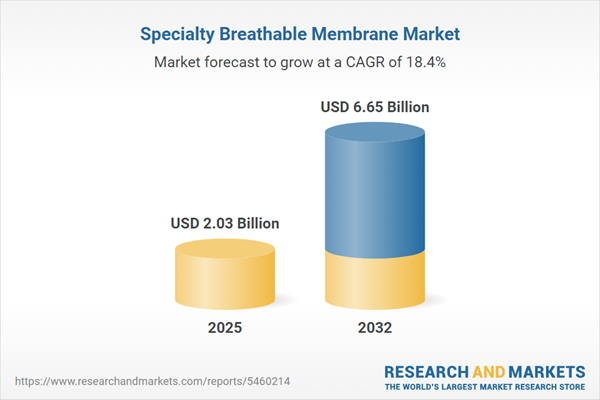Speak directly to the analyst to clarify any post sales queries you may have.
The specialty breathable membrane market is evolving rapidly, shaped by shifting end-user requirements, regulatory changes, and emerging environmental imperatives. As industries prioritize both protection and advanced functionality, demand for innovative membrane technologies continues to grow across core application segments and regions.
Market Snapshot: Specialty Breathable Membrane Market Growth and Outlook
The Specialty Breathable Membrane Market grew from USD 1.72 billion in 2024 to USD 2.03 billion in 2025. It is expected to continue growing at a CAGR of 18.41%, reaching USD 6.65 billion by 2032. This robust growth highlights expanding adoption across technical apparel, medical, automotive, and building sectors, reinforced by rising performance expectations and a heightened focus on sustainability and regulatory compliance. The market trajectory indicates a broad shift towards next-generation materials and process digitalization.
Scope & Segmentation
- Applications: Apparel and equipment, automotive (gaskets, interior trim, seat covers), building and construction (lining, roofing, waterproofing), industrial filtration, protective garments, medical (protective apparel, surgical barriers, wound dressings).
- Raw Materials: Expanded PTFE, polytetrafluoroethylene films, polyurethane composites, specialty breathable polymer membranes.
- Sales Channels: Aftermarket distribution, direct supply, original equipment manufacturers.
- End Users: Commercial, industrial, residential environments.
- Regional Coverage: Americas (North and Latin America), Europe, Middle East & Africa, Asia-Pacific. Key geographies include the United States, Canada, Brazil, United Kingdom, Germany, South Africa, China, India, Japan, Australia, and additional countries within each continental grouping.
- Company Analysis: Coverage includes W. L. Gore & Associates, Freudenberg Performance Materials, Ahlstrom-Munksjö, Toray Industries, SKC Co., Asahi Kasei, DuPont, Dow Chemical, Berry Global, and Nan Ya Plastics.
Key Takeaways for Decision-Makers
- Technological advancements in polymer chemistry and digital manufacturing are enabling the customization of breathable membrane performance for diverse industrial and medical applications.
- Sustainability considerations are increasingly central, prompting significant investment in eco-friendly materials, solvent-free coating processes, and life cycle analysis.
- Digitalization has streamlined quality control, making real-time monitoring and process analytics integral to ensuring product reliability and rapid product innovation cycles.
- Strategic collaborations are reshaping the competitive landscape, with partnerships across material developers, equipment suppliers, and end users driving rapid innovation and standardization.
- Distinct application needs drive material selection, with expanded PTFE and advanced polymer composites leading in sectors where durability and vapor transmission are critical.
- Complex routes to market—from aftermarket distribution for rapid industrial replenishment to tailored OEM partnerships—require close alignment between supplier capabilities and end-user demands.
Tariff Impact: Navigating US Trade Policy Shifts
With recent changes to United States tariff policy, cost structures for specialty breathable membrane production have shifted. Increased import duties on key polymer inputs have impacted manufacturer procurement strategies and prompted supply chain reevaluation. Some producers have adopted regional sourcing or adjusted logistics models to reduce financial exposure and maintain product continuity. These evolving trade dynamics underscore the importance of agile supplier partnerships and ongoing cost containment initiatives throughout the value chain.
Methodology & Data Sources
The analysis is built on a mixed-method approach, blending primary and secondary research across manufacturing and logistics domains. Insights were gathered via structured interviews, onsite facility assessments, corporate filings, and a broad review of technical journals, regulatory guidelines, and industry publications. Comprehensive data triangulation verified the credibility of findings and ensured robust scenario planning on future market shifts.
Why This Report Matters
- Enables informed strategic planning by providing actionable insights into evolving technology trends, regulatory frameworks, and market segmentation.
- Assists in de-risking procurement and supply chain decisions in light of shifting trade policies and sustainability imperatives.
- Equips decision-makers with reliable competitive intelligence and practical recommendations for segment targeting and partnership development.
Conclusion
This report equips senior leaders with a rigorous assessment of the specialty breathable membrane sector’s complexity and potential. It offers pathways to harness innovation, optimize market positioning, and anticipate challenges related to changing regulations and material advancements.
Additional Product Information:
- Purchase of this report includes 1 year online access with quarterly updates.
- This report can be updated on request. Please contact our Customer Experience team using the Ask a Question widget on our website.
Table of Contents
3. Executive Summary
4. Market Overview
7. Cumulative Impact of Artificial Intelligence 2025
List of Figures
Samples

LOADING...
Companies Mentioned
The key companies profiled in this Specialty Breathable Membrane market report include:- W. L. Gore & Associates, Inc.
- Freudenberg Performance Materials SE & Co. KG
- Ahlstrom-Munksjö Oyj
- Toray Industries, Inc.
- SKC Co., Ltd.
- Asahi Kasei Corporation
- DuPont de Nemours, Inc.
- The Dow Chemical Company
- Berry Global Group, Inc.
- Nan Ya Plastics Corporation
Table Information
| Report Attribute | Details |
|---|---|
| No. of Pages | 194 |
| Published | October 2025 |
| Forecast Period | 2025 - 2032 |
| Estimated Market Value ( USD | $ 2.03 Billion |
| Forecasted Market Value ( USD | $ 6.65 Billion |
| Compound Annual Growth Rate | 18.4% |
| Regions Covered | Global |
| No. of Companies Mentioned | 11 |









